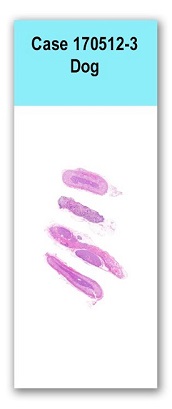Case 3 170512 (17B0324)
Conference Coordinator: Molly Liepnieks
//
Four-year-old, male Rottweiler dog.
This dog had a six-month-history of progressive paraparesis with acute collapse and vomiting. Bloodwork identified marked hyperlactemia and hyperglycemia. Hypotension was unresponsive even after a bolus of 3 L of intravenous fluids and a norepinephrine, continuous-rate infusion. Thoracic radiographs revealed mild pleural effusion and changes consistent with atelectasis or aspiration pneumonia. Abdominal ultrasound and CT imaging identified severe necrotizing pancreatitis and retro-peritonitis. Hypotension persisted despite norepinephrine CRI and dobutamine CRI. There was progressive hypoxemia, hyperlactemia, and decreased urinary output. The clinical problem list included diabetes mellitus, pancreatitis, acute kidney injury, and acute respiratory distress syndrome. The patient was euthanised due to a very poor prognosis.
Clinical chemistry values were as follows: Na 133, anion gap 35, K 5.5, Ci 84, phos 6.5, creatinine 2.1, glu 937, ALT 569, AST 934, cr 451, ALP 999, GGT 8, chol 1280, Mg 2.6, TT4 <0.5, FT4 0.30. CBC HCT 30.5%, retic 125,700, bands 2912, UA USG 1.047.
The abdominal cavity contained approximately 250 ml of opaque, tan to pink, opaque fluid. Minimal amounts of fibrin were present over the serosa of the gastrointestinal tract. The gastric mucosa had widely scattered, pinpoint to coalescing, mucosal hemorrhages and ulcers throughout the cardia and fundus. The pancreas was grossly enlarged and approximately 75% was covered by saponified fat.
The right lobe of the thyroid gland was 3 x 0.75 cm and the right lobe was of a similar size. The right adrenal cortex and medulla were 0.1 cm and 0.3 cm thick respectively. The left adrenal gland was similar in size.
The mitral valve leaflets were minimally thickened and there were 6 nodules along the valve leaflets that were smooth, tan to pink, and varied from 0.1 to 0.6 mm in diameter. The coronary vessels were moderately expanded by granular, white to tan material that occasionally extended into the parenchyma.
Both maxillary and mandibular brachygnathism are present (multiple maxillary and mandibular premolar teeth are rotated from a sagittal to transverse plane). The brachygnathia was most pronounced in the maxilla resulting in crossbite. Additionally there is malocclusion resulting in attrition
This slide contains one section of thyroid and parathyroid glands, in which the majority of thyroid follicles are replaced by a dense infiltrate of lymphocytes, plasma cells, and histiocytes along with fibrous connective tissue. The remaining follicles are frequently isolated. They are often irregularly shaped or are collapsed, and contain variable amounts of colloid. The follicles occasionally contain karryorhectic cellular debris. The internal elastic lamina of arteries is discontinuous and the tunica intima and media are disorganized and expanded by aggregates of lipid-laden macrophages (foam cells), lymphocytes, plasma cells, and numerous acicular cholesterol clefts (atherosclerosis).
Two sections of adrenal gland are also included on this slide. The zona fasciculata and zona reticularis are thin relative to the thickness of the zona glomerulosa. Lipid-filled vacuoles in the cells of the zona fasciculate are large, tend to coalesce and rarely marginalize the nuclei. The connective tissue in the cortex is slightly increased and vessels are often ectatic. The capsule is thickened.
No special stains.
Severe, chronic, regionally extensive lymphocytic, plasmacytic, histiocytic thyroiditis and generalized thyroid gland atrophy with severe chronic atherosclerosis.
Moderate, bilateral, adrenal, cortical atrophy.
The primary lesion of this dog was a severe, diffuse, necrotizing pancreatitis with pancreatic necrosis and fibrinous peritonitis. However, the small size of the thyroid glands combined with the evidence of atherosclerosis were highly suggestive of hypothyroidism. The atherosclerosis was striking and affected large arteries in many organs. In addition to the vessels within the thyroid, severe atherosclerosis was present in coronary arteries, pulmonary vein, spinal arteries and mesenteric artery.
Lymphocytic thyroiditis is generally an autoimmune process in dogs, although thyroglobulin autoantibodies were not identified clinically in this case. Atherosclerosis is rare in dogs and is almost always associated with hypothyroidism or diabetes mellitus. Both were indicated clinically in this case. Atherosclerosis associated with hypothyroidism is likely secondary to an altered lipid profile and endothelial injury secondary to hyperlipidemia.
Atherosclerosis within the arteries of the spinal cord likely contributed to the progressive paraperesis. Changes in the spinal cord, brainstem, and cerebellum were also consistent with neuroaxonal dystrophy, a condition seen in Rottweilers. However, this is speculative in light of the other lesions present. Hypothyroidism occurs in 0.2 to 0.8% of dogs and up to 7.5% of those have neurologic dysfunction.
Diabetes mellitus in this case was likely secondary to widespread loss of islet cells. The moderate bilateral atrophy of the adrenal glands is presumably secondary to steroid administration during the course of this dog’s disease.
Blois SL, Poma R, Stalker MJ, Allen DG. 2008. A case of primary hypothyroidism causing central nervous system atherosclerosis in a dog. The Canadian Veterinary Journal. 49(8):789.
Ichiki T. Thyroid hormone and atherosclerosis. 2010. Vascular pharmacology. 52(3):151-6.

